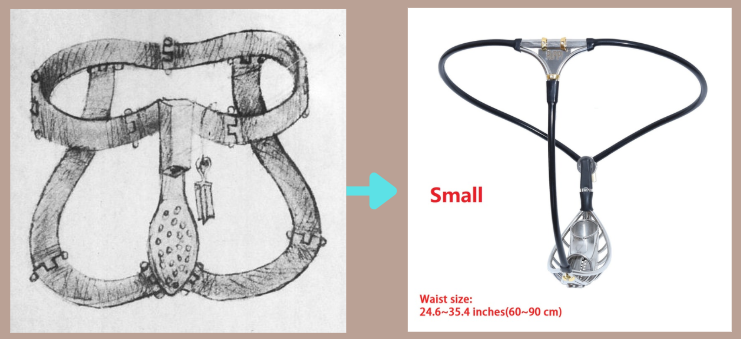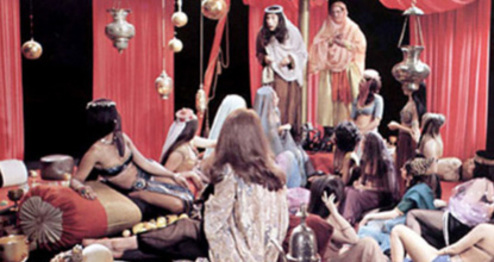The Chastity Belt: From Medieval Myth to Modern Symbol
2025-10-25
The chastity belt remains one of history's most misunderstood artifacts—long portrayed as an iron instrument of control and fidelity. Yet modern scholarship reveals a far more complex story, shaped by myth, moral anxiety, and later reinvention. This article traces the evolution of the chastity belt from its alleged medieval origins to its symbolic rebirth in modern culture.
1. Defining the Chastity Belt and Its Modern Counterpart
Historically, the term chastity belt refers to a protective garment—often imagined as a metal girdle locked around the waist to prevent sexual activity. In contrast, the chastity cage, a modern reinterpretation, is a smaller device (typically for men) designed for consensual erotic restraint.
While both share the theme of sexual restriction, their contexts differ completely: the chastity belt belongs to moral mythology, whereas the chastity cage functions within mutual consent and communication.

2. Origins and Documentary Evidence
Early references to devices resembling chastity belts appear in European writings between the 15th and 17th centuries, though few are reliable.
Scholars such as Albrecht Classen (University of Arizona) and museum curators from Vienna and Paris have emphasized that no verifiable archaeological samples from the medieval period confirm widespread use.
Some textual mentions—such as those in Konrad Kyeser's Bellifortis (circa 1405)—describe a leather or fabric girdle allegedly used for protection during wartime absences. However, no physical remnants of such leather or textile chastity garments have been authenticated; they exist only in manuscripts and artistic depictions.
Thus, current evidence suggests the idea of a "medieval chastity belt" was more symbolic than practical—an allegory for moral virtue rather than a real physical instrument.

3. Fabrication and Mythmaking in the 18th–19th Centuries
Most surviving antique chastity belts were actually created between the late 1700s and mid-1800s.
During the Victorian era, fascination with sexuality and morality led craftsmen to produce ornate metal "chastity belts" for display in curiosity cabinets and museums. These objects were marketed as relics of medieval discipline but were, in reality, products of industrial imagination.
Mainstream research, therefore, concludes that museum pieces once labeled as medieval are, in fact, later constructions. Nonetheless, their presence fueled popular myths—particularly the story of "knights locking their wives" before battle. While such anecdotes remain widespread, no verified historical record supports this specific practice.
4. Construction, Materials, and Practicality
Descriptions and replicas suggest early belts—if any functional examples existed—were crafted from iron plates, leather straps, or layered textiles.
However, practical issues like hygiene and infection made sustained use implausible. Even contemporary accounts criticized such designs as physically harmful.
In contrast, modern chastity cages address these limitations through material innovation:
- Medical-grade stainless steel prevents corrosion and ensures airflow.
- Silicone and polycarbonate models reduce skin irritation and allow cleaning without removal.
- Ergonomic shaping supports long-term comfort.
This evolution demonstrates how technological progress transformed an unwearable myth into a safe, consensual device—shifting from coercion to choice.
5. The Emergence of Male Chastity Devices
While historical chastity belts were depicted as female garments, male chastity cages emerged only in the late 20th century, paralleling the rise of BDSM and sexual self-discipline culture.
Initially introduced within fetish communities, these devices became tools for exploring control, patience, and trust.
The concept of "forced chastity" today refers not to physical coercion but to consensual power dynamics, where both participants agree on duration and rules. This distinction is crucial: contemporary chastity practices operate under explicit consent, safety measures, and communication—unlike the punitive myths of the past.
6. Interpreting Symbolism and Cultural Impact
Throughout history, the chastity belt has served as a metaphor for control, purity, and anxiety about female autonomy.
In art and literature, it appeared both as satire and warning—from Renaissance paintings that ridiculed jealousy to Victorian moral tales that condemned desire.
In modern media, the image persists—sometimes eroticized, sometimes comic—symbolizing the tension between restriction and liberation. Psychological studies even explore it as an emblem of self-restraint and voluntary submission, extending far beyond its supposed mechanical function.
7. Scholarly Consensus and Continuing Debate
Most historians now view the "medieval chastity belt" as a cultural myth constructed by later generations.
According to Albrecht Classen (2007) and the British Museum's 2015 review, "no proven medieval example survives; all known artifacts are post-Renaissance fabrications."
Still, debate continues: isolated documents hint at protective garments for soldiers' wives or traveling women, though none confirm prolonged or coercive use.
Hence, the cautious academic phrasing remains: "No verifiable evidence currently supports the existence of functional medieval chastity belts."
8. From Myth to Modern Symbol
The chastity belt's transformation—from moral legend to consensual fetish—reflects changing attitudes toward sexuality and agency.
Where medieval allegory framed chastity as obedience, modern reinterpretation sees the chastity cage as an expression of communication and trust.
What endures is the fascination: the object remains a cultural mirror, revealing each era's fears and fantasies about control, desire, and freedom.

Conclusion
The story of the chastity belt is ultimately about humanity's shifting relationship with sexuality, morality, and power.
From fabricated iron relics of the 19th century to modern precision-engineered chastity cages, the object evolved from a myth of repression into a symbol of consensual discipline.
Rather than proving medieval cruelty, it exposes how societies invent artifacts to embody their anxieties—and how those myths, once created, can last for centuries.









